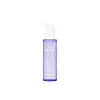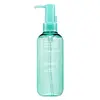What's inside
What's inside
 Key Ingredients
Key Ingredients

 Benefits
Benefits

 Concerns
Concerns

 Ingredients Side-by-side
Ingredients Side-by-side

Tromethamine
BufferingSorbeth-30 Tetraoleate
EmulsifyingSalicylic Acid
MaskingSodium Acetylated Hyaluronate
HumectantSodium Hyaluronate Crosspolymer
HumectantHyaluronic Acid
HumectantNiacinamide
SmoothingWater
Skin ConditioningSodium Guaiazulene Sulfonate
Sorbitan Sesquioleate
EmulsifyingCaprylic/Capric Triglyceride
MaskingButylene Glycol
HumectantHydrolyzed Hyaluronic Acid
HumectantParfum
MaskingArginine
MaskingHydroxypropyltrimonium Hyaluronate
Sodium Hyaluronate
HumectantCitric Acid
BufferingBetaine
HumectantPropanediol
SolventEthylhexyl Palmitate
EmollientHydrolyzed Glycosaminoglycans
HumectantDipropylene Glycol
HumectantGlycerin
HumectantPotassium Cetyl Phosphate
EmulsifyingHydrogenated Lecithin
EmulsifyingBenzyl Glycol
Solvent1,2-Hexanediol
Skin ConditioningSodium Surfactin
CleansingSodium Polyacryloyldimethyl Taurate
Emulsion StabilisingDisodium EDTA
Cetyl Ethylhexanoate
EmollientGluconolactone
Skin ConditioningPerilla Ocymoides Leaf Extract
TonicCopper Tripeptide-1
Skin ConditioningCapryloyl Salicylic Acid
ExfoliatingPalmitoyl Tripeptide-1
Skin ConditioningEthylhexylglycerin
Skin ConditioningTromethamine, Sorbeth-30 Tetraoleate, Salicylic Acid, Sodium Acetylated Hyaluronate, Sodium Hyaluronate Crosspolymer, Hyaluronic Acid, Niacinamide, Water, Sodium Guaiazulene Sulfonate, Sorbitan Sesquioleate, Caprylic/Capric Triglyceride, Butylene Glycol, Hydrolyzed Hyaluronic Acid, Parfum, Arginine, Hydroxypropyltrimonium Hyaluronate, Sodium Hyaluronate, Citric Acid, Betaine, Propanediol, Ethylhexyl Palmitate, Hydrolyzed Glycosaminoglycans, Dipropylene Glycol, Glycerin, Potassium Cetyl Phosphate, Hydrogenated Lecithin, Benzyl Glycol, 1,2-Hexanediol, Sodium Surfactin, Sodium Polyacryloyldimethyl Taurate, Disodium EDTA, Cetyl Ethylhexanoate, Gluconolactone, Perilla Ocymoides Leaf Extract, Copper Tripeptide-1, Capryloyl Salicylic Acid, Palmitoyl Tripeptide-1, Ethylhexylglycerin
Ethylhexyl Palmitate
EmollientSorbeth-30 Tetraoleate
EmulsifyingIsopropyl Myristate
EmollientTriethylhexanoin
MaskingSorbitan Sesquioleate
EmulsifyingPolyisobutene
Caprylic/Capric Triglyceride
MaskingCandida Bombicola/Glucose/Methyl Rapeseedate Ferment
AntimicrobialParfum
MaskingMelaleuca Alternifolia Leaf Oil
AntioxidantCaprylyl Glycol
EmollientEthylhexylglycerin
Skin ConditioningWater
Skin ConditioningTocopherol
AntioxidantAllantoin
Skin ConditioningBetaine Salicylate
AntimicrobialNiacinamide
SmoothingMaltodextrin
AbsorbentPanthenol
Skin Conditioning1,2-Hexanediol
Skin ConditioningCentella Asiatica Extract
CleansingMelaleuca Alternifolia Leaf Extract
PerfumingMelaleuca Alternifolia Leaf Water
AntimicrobialMelaleuca Alternifolia Flower/Leaf/Stem Extract
Skin ConditioningProtease
ExfoliatingSuperoxide Dismutase
AntioxidantEthylhexyl Palmitate, Sorbeth-30 Tetraoleate, Isopropyl Myristate, Triethylhexanoin, Sorbitan Sesquioleate, Polyisobutene, Caprylic/Capric Triglyceride, Candida Bombicola/Glucose/Methyl Rapeseedate Ferment, Parfum, Melaleuca Alternifolia Leaf Oil, Caprylyl Glycol, Ethylhexylglycerin, Water, Tocopherol, Allantoin, Betaine Salicylate, Niacinamide, Maltodextrin, Panthenol, 1,2-Hexanediol, Centella Asiatica Extract, Melaleuca Alternifolia Leaf Extract, Melaleuca Alternifolia Leaf Water, Melaleuca Alternifolia Flower/Leaf/Stem Extract, Protease, Superoxide Dismutase
Ingredients Explained
These ingredients are found in both products.
Ingredients higher up in an ingredient list are typically present in a larger amount.
1,2-Hexanediol is a synthetic liquid and another multi-functional powerhouse.
It is a:
- Humectant, drawing moisture into the skin
- Emollient, helping to soften skin
- Solvent, dispersing and stabilizing formulas
- Preservative booster, enhancing the antimicrobial activity of other preservatives
This ingredient is an emollient, solvent, and texture enhancer. It is considered a skin-softener by helping the skin prevent moisture loss.
It helps thicken a product's formula and makes it easier to spread by dissolving clumping compounds.
Caprylic Triglyceride is made by combining glycerin with coconut oil, forming a clear liquid.
While there is an assumption Caprylic Triglyceride can clog pores due to it being derived from coconut oil, there is no research supporting this.
Learn more about Caprylic/Capric TriglycerideEthylhexyl Palmitate, also known as octyl palmitate, is created from 2-ethylhexyl alcohol and palmitic acid. It is a fatty acid ester.
The fatty acid content of Ethylhexyl Palmitate makes it an emollient. Emollients help soften and hydrate your skin by trapping moisture within.
Ethylhexyl Palmitate is also used to help improve the texture of cosmetics. It helps other ingredient dissolve in products and help disperse ingredients more evenly.
You'll likely find this ingredient in sunscreen, as it is often used to mix UV-blocking ingredients such as avobenzone and ethylhexyl triazone.
It can also help stabilize the fragrances in a product as a fragrance fixative.
Ethylhexyl Palmitate can be used to substitute mineral oil.
Due to its high fatty acid content, it may not be fungal-acne safe.
Learn more about Ethylhexyl PalmitateEthylhexylglycerin (we can't pronounce this either) is commonly used as a preservative and skin softener. It is derived from glyceryl.
You might see Ethylhexylglycerin often paired with other preservatives such as phenoxyethanol. Ethylhexylglycerin has been found to increase the effectiveness of these other preservatives.
Niacinamide is a multitasking form of vitamin B3 that strengthens the skin barrier, reduces pores and dark spots, regulates oil, and improves signs of aging.
And the best part? It's gentle and well-tolerated by most skin types, including sensitive and reactive skin.
You might have heard of "niacin flush", or the reddening of skin that causes itchiness. Niacinamide has not been found to cause this.
In very rare cases, some individuals may not be able to tolerate niacinamide at all or experience an allergic reaction to it.
If you are experiencing flaking, irritation, and dryness with this ingredient, be sure to double check all your products as this ingredient can be found in all categories of skincare.
When incorporating niacinamide into your routine, look out for concentration amounts. Typically, 5% niacinamide provides benefits such as fading dark spots. However, if you have sensitive skin, it is better to begin with a smaller concentration.
When you apply niacinamide to your skin, your body converts it into nicotinamide adenine dinucleotide (NAD). NAD is an essential coenzyme that is already found in your cells as "fuel" and powers countless biological processes.
In your skin, NAD helps repair cell damage, produce new healthy cells, support collagen production, strengthen the skin barrier, and fight environmental stressors (like UV and pollution).
Our natural NAD levels start to decline with age, leading to slower skin repair, visible aging, and a weaker skin barrier. By providing your skin niacinamide, you're recharging your skin's NAD levels. This leads to stronger, healthier, and younger looking skin.
Another name for vitamin B3 is nicotinamide. This vitamin is water-soluble and our bodies don't store it. We obtain Vitamin B3 from either food or skincare. Meat, fish, wheat, yeast, and leafy greens contain vitamin B3.
The type of niacinamide used in skincare is synthetically created.
Learn more about NiacinamideParfum is a catch-all term for an ingredient or more that is used to give a scent to products.
Also called "fragrance", this ingredient can be a blend of hundreds of chemicals or plant oils. This means every product with "fragrance" or "parfum" in the ingredients list is a different mixture.
For instance, Habanolide is a proprietary trade name for a specific aroma chemical. When used as a fragrance ingredient in cosmetics, most aroma chemicals fall under the broad labeling category of “FRAGRANCE” or “PARFUM” according to EU and US regulations.
The term 'parfum' or 'fragrance' is not regulated in many countries. In many cases, it is up to the brand to define this term.
For instance, many brands choose to label themselves as "fragrance-free" because they are not using synthetic fragrances. However, their products may still contain ingredients such as essential oils that are considered a fragrance by INCI standards.
One example is Calendula flower extract. Calendula is an essential oil that still imparts a scent or 'fragrance'.
Depending on the blend, the ingredients in the mixture can cause allergies and sensitivities on the skin. Some ingredients that are known EU allergens include linalool and citronellol.
Parfum can also be used to mask or cover an unpleasant scent.
The bottom line is: not all fragrances/parfum/ingredients are created equally. If you are worried about fragrances, we recommend taking a closer look at an ingredient. And of course, we always recommend speaking with a professional.
Learn more about ParfumSorbeth-30 Tetraoleate is a surfactant and emulsifier.
This ingredient is a tetraester from oleic acid and polyethylene glycol ether of sorbitol.
As an emulsifier, it helps ingredients such as oil and water mix together. This allows the dirt and oils in your skin to be washed away.
One study found pumpkin oil containing Sorbeth-30 Tetraoleate helped hydrate the skin and did not cause any irritation.
Learn more about Sorbeth-30 TetraoleateSorbitan Sesquioleate is derived from sorbitol and oleic acid. It is an emulsifier and prevents ingredients from separating.
Specifically, this ingredient is a water-in-oil emulsifier, meaning it helps water dissolve into oil.
Some studies suggest this ingredient may cause irritation in some people. If you are unsure, it is best to patch test.
This ingredient may not be Malassezia folliculitis, or fungal-acne safe.
Learn more about Sorbitan SesquioleateWater. It's the most common cosmetic ingredient of all. You'll usually see it at the top of ingredient lists, meaning that it makes up the largest part of the product.
So why is it so popular? Water most often acts as a solvent - this means that it helps dissolve other ingredients into the formulation.
You'll also recognize water as that liquid we all need to stay alive. If you see this, drink a glass of water. Stay hydrated!
Learn more about Water